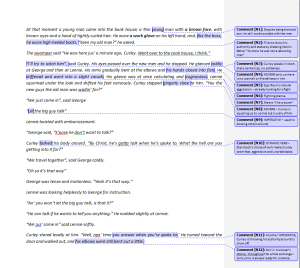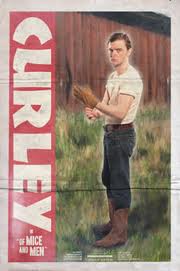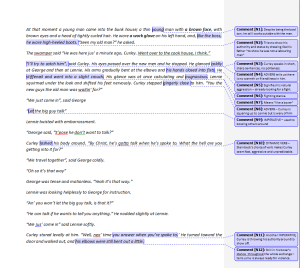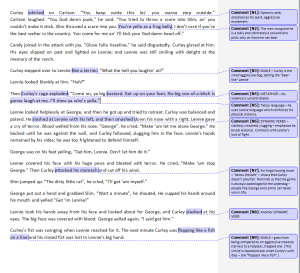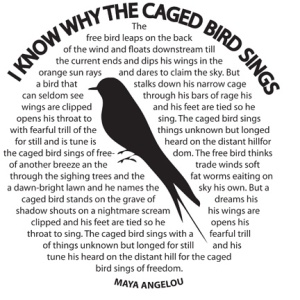
Please find below all Of Mice and Men questions from the AQA Literature exam from the past few years. As you can see, the question provides you with a short extract from the novel, and asks you to read the passage before answering part A and part B.
- Part A asks you to closely analyse the methods and techniques used by Steinbeck to create a particular atmosphere, describe an important setting, convey a particular theme or present an interesting character. It is imperative that you think carefully about why Steinbeck has chosen specific words and images, and the effect this creates in the reader. For this question, really ZOOM IN on the connotations of language and feelings presented.
- Part B will ask you to link the extract to the social, historical and cultural context of the novel – 1930s America. You will have to ZOOM OUT on the extract to examine how it demonstrates what life was like for those living in this particular time period, and how this is also presented in the rest of the novel.
You should spend no more than 45 minutes answering this question. There is no set rule, but I personally recommend that you focus on part A for 25 minutes, leaving 20 minutes for part B and proofreading your work.
The question is marked out of 30, with four marks being awarded for accurate and sophisticated spelling, punctuation and grammar. Therefore, please ensure that you edit your work in the final few minutes of the exam, correcting simple mistakes.
Finally, feel free to attempt any of the following questions and add your response in the comments section. I will happily mark all answers and provide you with critical feedback.
Enjoy!
Sir
Higher Tier Of Mice and Men – Jan 2011
Read the passage and then answer part (a) and part (b).
The old man was reassured. He had drawn a derogatory statement from George. He felt safe now, and he spoke more confidently. ‘Wait’ll you see Curley’s wife.’
George cut the cards again and put out a solitaire lay, slowly and deliberately.
‘Purty?’ he asked casually.
‘Yeah. Purty … but ––’
George studied his cards. ‘But what?’
‘Well – she got the eye.’
‘Yeah? Married two weeks and got the eye? Maybe that’s why Curley’s pants is full of ants.’
‘I seen her give Slim the eye. Slim’s a jerkline skinner. Hell of a nice fella. Slim don’t need to wear no high-heeled boots on a grain team. I seen her give Slim the eye. Curley never seen it. An’ I seen her give Carlson the eye.’
George pretended a lack of interest. ‘Looks like we was gonna have fun.’
The swamper stood up from his box. ‘Know what I think?’ George did not answer.
‘Well, I think Curley’s married … a tart.’
‘He ain’t the first,’ said George. ‘There’s plenty done that.’
The old man moved toward the door, and his ancient dog lifted his head and peered about, and then got painfully to his feet to follow. ‘I gotta be settin’ out the wash basins for the guys. The teams’ll be in before long. You guys gonna buck barley?’
‘Yeah.’
‘You won’t tell Curley nothing I said?’
‘Hell no.’
‘Well, you look her over, mister. You see if she ain’t a tart.’ He stepped out the door into the brilliant sunshine.
Part (a)
(a) What methods does Steinbeck use in this passage to present Candy?
and then Part (b)
(b) How do you think Steinbeck uses the character of Candy in the novel as a whole to
convey important ideas about society at that time? (30 marks)
Higher Tier Of Mice and Men – Jun 2011
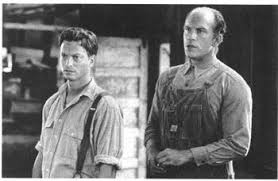
Read the passage and then answer part (a) and part (b)
‘I don’t want no fights,’ said Lennie. He got up from his bunk and sat down at the table, across from George. Almost automatically George shuffled the cards and laid out his solitaire hand. He used a deliberate, thoughtful, slowness.
Lennie reached for a face card and studied it, then turned it upside down and studied it. ‘Both ends the same,’ he said, ‘George, why is it both end’s the same?’
‘I don’t know,’ said George. ‘That’s jus’ the way they make ’em. What was Slim doin’ in the barn when you seen him?’
‘Slim?’
‘Sure. You seen him in the barn, an’ he tol’ you not to pet the pups so much.’
‘Oh yeah. He had a can a’ tar an’ a paint brush. I don’t know what for.’
‘You sure that girl didn’t come in like she come in here today?’
‘No. She never come.’
George sighed. ‘You give me a good whore house every time,’ he said. ‘A guy can go in an’ get drunk and get ever’thing outta his system all at once, an’ no messes. And he knows how much it’s gonna set him back. These here jail baits is just set on the trigger of the hoosegow.’
Lennie followed his words admiringly, and moved his lips a little to keep up. George continued, ‘You remember Andy Cushman, Lennie? Went to grammar school?’
‘The one that his old lady used to make hot cakes for the kids?’ Lennie asked.
‘Yeah. That’s the one. You can remember anything if there’s anything to eat in it.’
George looked carefully at the solitaire hand. He put an ace up on his scoring rack and piled a two, three and four of diamonds on it. ‘Andy’s in San Quentin right now on account of a tart,’ said George.
Lennie drummed on the table with his fingers. ‘George?’
‘Huh?’’
‘George, how long’s it gonna be till we get that little place an’ live on the fatta the
lan’ – an’ rabbits?’
Part (a)
(a) How do the details in this passage add to your understanding of George and his
relationship with Lennie?
and then Part (b)
(b) How does Steinbeck use their relationship in the novel as a whole to convey ideas
about America in the 1930s? (30 marks)
Higher Tier Of Mice and Men – Jan 2012

Read the following passage and then answer part (a) and part (b).
The bunk house was a long, rectangular building. Inside, the walls were whitewashed and the floor unpainted. In three walls there were small, square windows, and in the fourth, a solid door with a wooden latch. Against the walls were eight bunks, five of them made up with blankets and the other three showing their burlap ticking. Over each bunk there was nailed an apple box with the opening forward so that it made two shelves for the personal belongings of the occupant of the bunk. And these shelves were loaded with little articles, soap and talcum powder, razors and those Western magazines ranch men love to read and scoff at and secretly believe. And there were medicines on the shelves, and little vials, combs; and from nails on the box sides, a few neckties. Near one wall there was a black cast-iron stove, its stove-pipe going
straight up through the ceiling. In the middle of the room stood a big square table littered with playing cards, and around it were grouped boxes for the players to sit on.
At about ten o’clock in the morning the sun threw a bright dust-laden bar through one of the side windows, and in and out of the beam flies shot like rushing stars.
The wooden latch raised. The door opened and a tall, stoop-shouldered old man came in. He was dressed in blue jeans and he carried a big push-broom in his left hand. Behind him came George, and behind George, Lennie.
‘The boss was expectin’ you last night,’ the old man said. ‘He was sore as hell when you wasn’t here to go out this morning.’ He pointed with his right arm, and out of the sleeve came a round stick-like wrist, but no hand. ‘You can have them two beds there,’ he said, indicating two bunks near the stove.
George stepped over and threw his blankets down on the burlap sack of straw that was a mattress. He looked into the box shelf and then picked a small yellow can from it. ‘Say. What the hell’s this?’
‘I don’t know,’ said the old man.
‘Says “positively kills lice, roaches, and other scourges”. What the hell kind of bed you giving us, anyways. We don’t want no pants rabbits.’
Part (a)
How does Steinbeck use details in this passage to present the bunkhouse and its
inhabitants?
and then Part (b)
In the rest of the novel, how does Steinbeck present the lives of ranch workers at that
time? (30 marks)
Higher Tier Of Mice and Men – Jun 2012
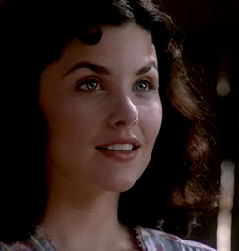
Read the following passage and then answer part (a) and part (b).
Both men glanced up, for the rectangle of sunshine in the doorway was cut off. A girl was standing there looking in. She had full, rouged lips and wide-spaced eyes, heavily made up. Her fingernails were red. Her hair hung in little rolled clusters, like sausages. She wore a cotton house dress and red mules, on the insteps of which were little bouquets of red ostrich feathers. ‘I’m lookin’ for Curley,’ she said. Her voice had a nasal, brittle quality.
George looked away from her and then back. ‘He was in here a minute ago, but he
went.’
‘Oh!’ She put her hands behind her back and leaned against the door frame so that her body was thrown forward. ‘You’re the new fellas that just come, ain’t ya?’
‘Yeah.’
Lennie’s eyes moved down over her body, and though she did not seem to be looking at Lennie she bridled a little. She looked at her fingernails. ‘Sometimes Curley’s in here,’ she explained.
George said brusquely, ‘Well he ain’t now.’
‘If he ain’t, I guess I better look some place else,’ she said playfully.
Lennie watched her, fascinated. George said, ‘If I see him, I’ll pass the word you was looking for him.’
She smiled archly and twitched her body. ‘Nobody can’t blame a person for lookin’,’ she said. There were footsteps behind her, going by. She turned her head. ‘Hi, Slim,’ she said.
Slim’s voice came through the door, ‘Hi, good-lookin’.’
‘I’m tryin’ to fi nd Curley, Slim.’
‘Well, you ain’t tryin’ very hard. I seen him goin’ in your house.’
She was suddenly apprehensive. ‘Bye, boys,’ she called into the bunk house, and she hurried away.
George looked around at Lennie. ‘Jesus, what a tramp,’ he said. ‘So that’s what Curley picks for a wife.’
Part (a)
In this passage, what methods does Steinbeck use to present Curley’s wife and the
attitudes of others to her? Refer closely to the passage in your answer.
and then Part (b)
How does Steinbeck present attitudes to women in the society in which the novel is set?
(30 marks)
Higher Tier Of Mice and Men – Jan 2013
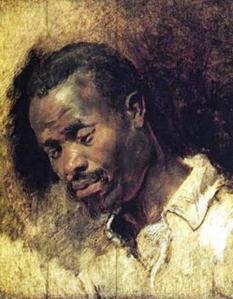
Read the following passage and then answer Part (a) and Part (b).
Crooks possessed several pairs of shoes, a pair of rubber boots, a big alarm clock and a single-barreled shotgun. And he had books, too; a tattered dictionary and a mauled copy of the California civil code for 1905. There were battered magazines and a few dirty books on a special shelf over his bunk. A pair of large gold-rimmed spectacles hung from a nail on the wall above his bed.
This room was swept and fairly neat, for Crooks was a proud, aloof man. He kept his distance and demanded that other people kept theirs. His body was bent over to the left by his crooked spine, and his eyes lay deep in his head, and because of their depth seemed to glitter with intensity. His lean face was lined with deep black wrinkles, and he had thin, pain-tightened lips which were lighter than his face.
It was Saturday night. Through the open door that led into the barn came the sound of moving horses, of feet stirring, of teeth champing on hay, of the rattle of halter chains. In the stable buck’s room a small electric globe threw a meager yellow light.
Crooks sat on his bunk. His shirt was out of his jeans in back. In one hand he held a bottle of liniment, and with the other he rubbed his spine. Now and then he poured a few drops of the liniment into his pink-palmed hand and reached up under his shirt to rub again. He flexed his muscles against his back and shivered.
Noiselessly Lennie appeared in the open doorway and stood there looking in, his big shoulders nearly fi lling the opening. For a moment Crooks did not see him, but on raising his eyes he stiffened and a scowl came on his face. His hand came out from under his shirt.
Lennie smiled helplessly in an attempt to make friends.
Crooks said sharply, ‘You got no right to come in my room. This here’s my room. Nobody got any right in here but me.’
Part (a)
In this passage, how does Steinbeck present Crooks? Refer closely to the passage in
your answer.
and then Part (b)
In the rest of the novel how does Steinbeck use Crooks to present attitudes to black
people at the time the novel is set? (30 marks)
SPaG: (4 marks)
Higher Tier Of Mice and Men – June 2013
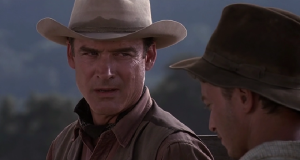
Read the following passage and then answer Part (a) and Part (b).
A tall man stood in the doorway. He held a crushed Stetson hat under his arm while he combed his long, black, damp hair straight back. Like the others he wore blue jeans and a short denim jacket. When he had finished combing his hair he moved into the room, and he moved with a majesty only achieved by royalty and master craftsmen. He was a jerkline skinner, the prince of the ranch, capable of driving ten, sixteen, even twenty mules with a single line to the leaders. He was capable of killing a fly on the wheeler’s butt with a bull whip without touching the mule. There was a gravity in his manner and a quiet so profound that all talk stopped when he spoke.
His authority was so great that his word was taken on any subject, be it politics or love. This was Slim, the jerkline skinner. His hatchet face was ageless. He might have been thirty-five or fifty. His ear heard more than was said to him, and his slow speech had overtones not of thought, but of understanding beyond thought. His hands, large and lean, were as delicate in their action as those of a temple dancer. He smoothed out his crushed hat, creased it in the middle and put it on. He looked kindly at the two in the bunk house. ‘It’s brighter’n a bitch outside,’ he said gently.
‘Can’t hardly see nothing in here. You the new guys?’
‘Just come,’ said George.
‘Gonna buck barley?’
‘That’s what the boss says.’
Slim sat down on a box across the table from George. He studied the solitaire hand that was upside down to him. ‘Hope you get on my team,’ he said. His voice was very gentle. ‘I gotta pair of punks on my team that don’t know a barley bag from a blue ball. You guys ever bucked any barley?’
Part (a)
In this passage, how does Steinbeck present Slim? Refer closely to the passage in your
and then Part (b)
In the rest of the novel, how does Steinbeck show that some people on the ranch are
considered more important than others? How does this reflect the society in which the
novel is set?(30 marks)
